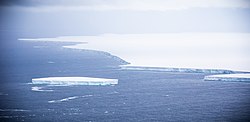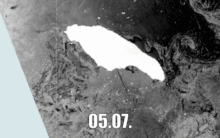Iceberg A-68 | |
|---|---|
 A-68A on 18 November 2020 | |
| Part of | Larsen C ice shelf (originally) |
| Offshore water bodies | South Atlantic |
| Area | |
| • Total | 5,800 km2 (2,200 sq mi) (at break) |
| Dimensions | |
| • Length | 175 km (109 mi) (at break) |
| • Width | 50 km (31 mi) (at break) |



Iceberg A-68 was a giant tabular iceberg adrift in the South Atlantic, having calved from Antarctica's Larsen C ice shelf in July 2017.[1][2][3] By 16 April 2021, no significant fragments remained.[4]
With a surface area of 5,800 square kilometres (2,200 sq mi), twice the size of Luxembourg, over a quarter the size of Wales, and larger than Delaware,[5] it was one of the largest recorded icebergs, the largest being B-15 which measured 11,000 square kilometres (4,200 sq mi) before breaking up. The calving of A-68 reduced the overall size of the Larsen C shelf by 12 percent.[5][6]
Historical data shows that many icebergs that break off from the Antarctic Peninsula reach South Georgia and the South Sandwich Islands.[7]
The name "A-68" was assigned by the US National Ice Center. It broke into parts with the mother berg dubbed A-68A. The larger child icebergs were designated in order of birthing, as A-68B, A-68C, A-68D, A-68E, A-68F, and in January 2021, splitting almost in half to birth A-68G. On 30 January 2021, Iceberg A-68A broke into other icebergs called A-68H, A-68I, A-68J, A-68K, A-68L, A-68M.
- ^ "Larsen C calves trillion ton iceberg". Project MIDAS. 12 July 2017. Archived from the original on 12 July 2017. Retrieved 12 July 2017.
- ^ "Giant iceberg splits from Antarctic". BBC. 12 July 2017.
- ^ "Massive iceberg breaks away from Antarctica". CNN. 12 July 2017. Retrieved 13 July 2017.
- ^ Cite error: The named reference
Amosendwas invoked but never defined (see the help page). - ^ a b Davis, Nicola (2 August 2017). "What happened next to the giant Larsen C iceberg?". The Guardian. ISSN 0261-3077. Retrieved 2 August 2017.
- ^ McKie, Robin (31 January 2021). "Extraordinary voyage: on the trail of the trillion-tonne runaway iceberg". The Observer. ISSN 0029-7712. Retrieved 31 January 2021.
- ^ Mosher, Dave (12 July 2017). "Where Antarctic iceberg from Larsen C shelf might go in Southern Ocean". Business Insider. Retrieved 21 July 2017.